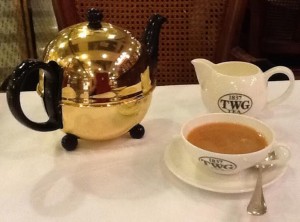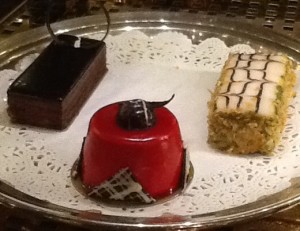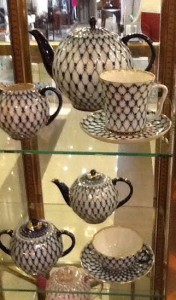 “Weary, after a dull day, with the prospect of a depressing morrow, I raised my lips to a spoonful of the tea in which I had soaked a morsel of cake… And at once the vicissitudes of life had become indifferent to me.” – Marcel Proust, 1913
“Weary, after a dull day, with the prospect of a depressing morrow, I raised my lips to a spoonful of the tea in which I had soaked a morsel of cake… And at once the vicissitudes of life had become indifferent to me.” – Marcel Proust, 1913
At this time of year, the round of farewells amongst the expat community can make a girl a little melancholy. But I am over-riding the sadness of endless send-offs with a number of inevitably cheerful, chatty afternoons of tea and scones and quite possibly champagne. Today, however, I am alone, sipping tea and nibbling on bite-sized mini burgers at 1837 TWG. And nothing could be nicer, except perhaps the unexpected appearance of a good friend….
You have probably noticed my penchant for afternoon tea by now, and ‘TWG’, with a list of teas more extensive than any wine list I have ever experienced, must surely be the tea connoisseur. With a current selection of more than 800 varieties, the choice would be daunting, except that they have been conveniently classified according to region, country, and time of day. And as if that were not enough there is even a separate tea book with vivid descriptions of the various teas.
Fancy a London High Tea to accompany your cakes? “A demure blend of nostalgic taste, this whole-leaf black tea pays tribute to a cosmopolitan city by showcasing the best of Chinese and Indian savoir-faire  in an enduring cup.”
in an enduring cup.”
Or a Literary Tea? “Aromatic, this blend of fruity green tea shields a strong and lingering taste of
moonlit nights and secret trysts. A tea of fairy tale endings.”
Emperor’s White Garden Tea perhaps? “To instill the palate with harmonizing fragrances, freshness and warmth, fine white tea, green tea and highly aromatic roses and jasmine blossoms are blended to evoke a sense of appeasing serenity after the day’s upheavals.”
And I thought the winemakers had cornered the market on evocative adjectives!
Despite an initial reluctance to be wooed by such pretentiousness, I have been converted. Who needs wine, coffee or chocolate when so much adventure can be found in a simple cup of tea? So I am working my way through the list, with a decided preference for the black teas. It is a lucky dip of poetic names likes Ace of Hearts, Royal Orchid, Smoky Russian and Chittagong Hill. And who knew there was more than one type of Earl Grey? TWG lists fourteen. Tea even makes its presence felt in the food menu, flavouring cocktail sauces, macaroons and ice creams and infused into vinaigrettes and jellies.
Whether you feel like breakfast, lunch or afternoon tea, tea is the star of the menu, blending everything together in a fanciful conceit.
So from whence came The Wellness Group and its expertise in tea? The story goes back to the founding of modern Singapore in 1819 by Sir Stamford Raffles. Established as a trading post of the British East India Company with the permission of the Johor Sultanate, it rapidly developed into a flourishing free port at the crossroads of the SE Asian sea routes, trading in tea and coffee, cotton, sugar and spices. In 1837, the tea trade in Singapore was formalized with the creation of the Chamber of Commerce. In recognition of the role Singapore has played in the tea trade, The Wellness Group set up 1837 TWG Tea in 2007, continuing a tradition that it claims to have ‘spiced with a touch of sensuality and originality.’
 The history of tea itself begins hundreds of years ago in China, where it was first mentioned around 300AD. The Chinese came to consider it an exotic cure for almost everything and even believed it might be the key to eternal life.
The history of tea itself begins hundreds of years ago in China, where it was first mentioned around 300AD. The Chinese came to consider it an exotic cure for almost everything and even believed it might be the key to eternal life.
Tea did not arrive in Britain until the mid-seventeenth century, when, thanks to its popularity with the wife of Charles II, Catherine of Braganza, , tea developed an image as a feminine drink, served with a plethora of silver and porcelain accoutrements, and the added bonus of numerous unproven health benefits.
Due to excessive taxes, the price of tea made it an upper class commodity, until prolific smuggling forced the government to lower the taxes, so much so that its connotations of affluence dropped accordingly and it became the drink of the masses.
Tea has even influenced the course of history. In 1773, it played a lead role in America’s fight for independence from Britain, when rebellious colonists emptied hundreds of tea chests into the sea, thus instigating the American Revolution at what came to be known as the Boston Tea Party.
In the nineteenth century, the British obsession with tea led to the Opium War with the Chinese, who resented Britain’s refusal to pay for their tea in silver, as requested, instead paying in that addictive drug, opium. The war, eventually won by the British, led to their acquisition of Hong Kong.
By the 1930s, tea had become a national institution in Britain, glorified by the Lyons Tea Houses, whose waitresses – or ‘nippys’ – were renowned as the most efficient service staff in the country.
Today, tea is the panacea of the nation and an integral part of British culture. Writer George Orwell described it as “one of the main stays of civilization in this country, as well as in Eire, Australia and New Zealand. “ And it has retained its reputation as a cure-all, in a country where every illness or family  tragedy is dealt with by immediately putting on the kettle for a cup of tea.
tragedy is dealt with by immediately putting on the kettle for a cup of tea.
Early Australian settlers became some of the most prolific tea drinkers in the world. ‘Billy tea,’ now a popular brand of teabags, also refers to the tin can used to make tea over a campfire; the bushman’s kettle, and stars in such national songs as Banjo Paterson’s Waltzing Matilda and in the writings of Henry Lawson’s and D’Arcy Niland.
And so this Australian upholds the habits of her countrymen and women in the Philippines by drinking two pots of tea quite happily in one sitting – although I would perhaps prefer a large Aussie mug to the dainty, shallow tea cups that can be emptied down a thirsty throat in a single gulp.
